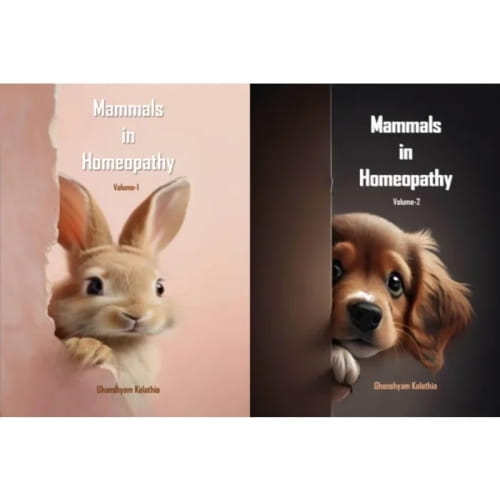- Home
- Author
- Lotus Wellness Cottage
- Books
- Materia Medica
- Mammals in Homeopathy (2 Volumes)
Mammals in Homeopathy (2 Volumes)
Mammals in Homeopathy is a book about Mammal Remedies materia medica, themes, and cases of known and newly proved 100 remedies.
The books have the following features:
- 29 Chapters
- 26 Families or Orders
- 130 Charts for easy reference
- Small Repertory for Themes
- 22 Cured cases
- Author: Ghanshyam Kalathia
- ISBN: 99331000034
- 560 pages
- Hardback
- Published in 2021
- Printed in India (so could be of inferior quality)
Reprinted with the permission of The Society of Homeopaths, from 'New Homeopath' Journal, Spring 2022 edition. Reviewed by Vatsala Sperling.
This is a shortened version of Vatsala Sperling's review first published in the e-journal HPATHY, November 2021.
After his book on Invertebrates in Homeopathy, Dr Ghanshyam Kalathia has produced these two companion volumes on Mammals in Homeopathy.
They offer a clear-cut, direct, uncluttered and very practical approach to studying mammal remedies as we move through a total of 29 chapters and 22 cases.
While both volumes are full of useful information and insight, chapter 29 - Quick Reference - offers the icing on the cake, so to speak. Here you are treated to a 'thematic index', a compilation of extracted themes written in alphabetical order. For example - Lac suilinum and Lac asinum share similarities; Lac felinum and Vulpus vulpus also share common characteristics. In the thematic index we can find the common themes running through the remedies. As a result, whenever we are looking for a particular theme, we can find all the mammal remedies that share it. The index pulls together all the mammalian themes and helps us in distinguishing between remedies that share a common theme.
Pages 497 to 507 constitute an elaborate thematic index for mammalian remedies, that looks exactly like a repertory. This one aspect is a brilliant high point of these two volumes on mammal remedies.
Another strong point presented in chapter 29, is a table of mammal remedies and their miasms. All miasms as taught by Dr Rajan Sankaran are listed except the psoric miasm. Another table connects mammalian remedies to the rows of the elemental periodic table, and in this regard, the pioneering work of Dr Bhawisha and Dr Sachindra Joshi seems to have inspired Dr Kalathia.
In this very same chapter, the section on charts contains neat tables that bear basic features, associated features, as well as defence and reaction patterns of a total of 87 different mammals. This is rich, and it constitutes a very attractive and useful part of these volumes, elevating them to the category of 'must read'.
A table of contents for both volumes is only given at the beginning of Volume 1. For convenience I photocopied the contents to slip into the front of Volume 2.
In Volume 1 of Mammals in Homeopathy, Dr Kalathia describes prey mammals: Bovidae (hoofed mammals), Cervidae (deer), Suidae (pigs), Camalidae, Giraffidae, Hippopotamidae, Equidae (zebras, horses), Rhinocerotidae, Elephantidae, Sirenia (sea cows), Cetacea (whales, dolphins), Primates, Rodentia, Insectivora (shrews, moles, hedgehogs), Chiroptera (bats), Xenarthra (sloths, anteaters), and marsupials. Matridonal remedies follow the chapter on Primates.
Volume 2 has chapters on predator mammals from Felidae, Canidae, Hyanidae (hyeneas), Ursidae (bears), Pinnipedia (seals), Musteloidae (badgers, otters, ferrets), and Herpestidae (mongooses). Each of these chapters contains brief general information. The group themes are given in adequate detail, and these are also summarises in a table in each chapter.
Remedies from various mammalian groups are handled with precision and they cover general information, personality of people needing these remedies, main characteristics of these personalities, and generally encountered symptoms. There are also lists of rubrics associated with remedies.
Volume 1 and 2 is purely a presentation of information that will enable us to spot a mammalian remedy in our cases if we focus on the emerging themes. A succinct explanation of themes is a strength of these volumes as is also the differentiation between similar mammals.
The cases have been abbreviated and edited for clarity and include analysis, mammal issues in the case, basic qualities of the patients, repertorisation of these qualities and symptoms, remedy and potency choice, follow up and conclusion. Cases have been contributed by various practitioners and the prescriptions are from 14 lac remedies, as well as Moschus, Panthera pardus and Acinonyx. Hopefully, in upcoming editions, Dr Kalathia will share cases from a diverse range of mammalian remedies.
Having tremendously enjoyed reading these two volumes on Mammals in Homeopathy I can confidently predict the usefulness of these books: they could become the go-to reference book in the genre of animal/mammal remedies.
Vatsala Sperling, RSHom (NA), CCH, MS, PhD, PDHom was the Chief of Clinical Microbiology services at a Chennai children's hospital and conducted research with WHO, Denmark. Vatsala studied Homeopathy with Misha Norland's school and continues to study and practise classical homeopathy. She has served on a board of directors of NASH and is currently a volunteer with NCH. She lives in Vermont with her husband and son.

